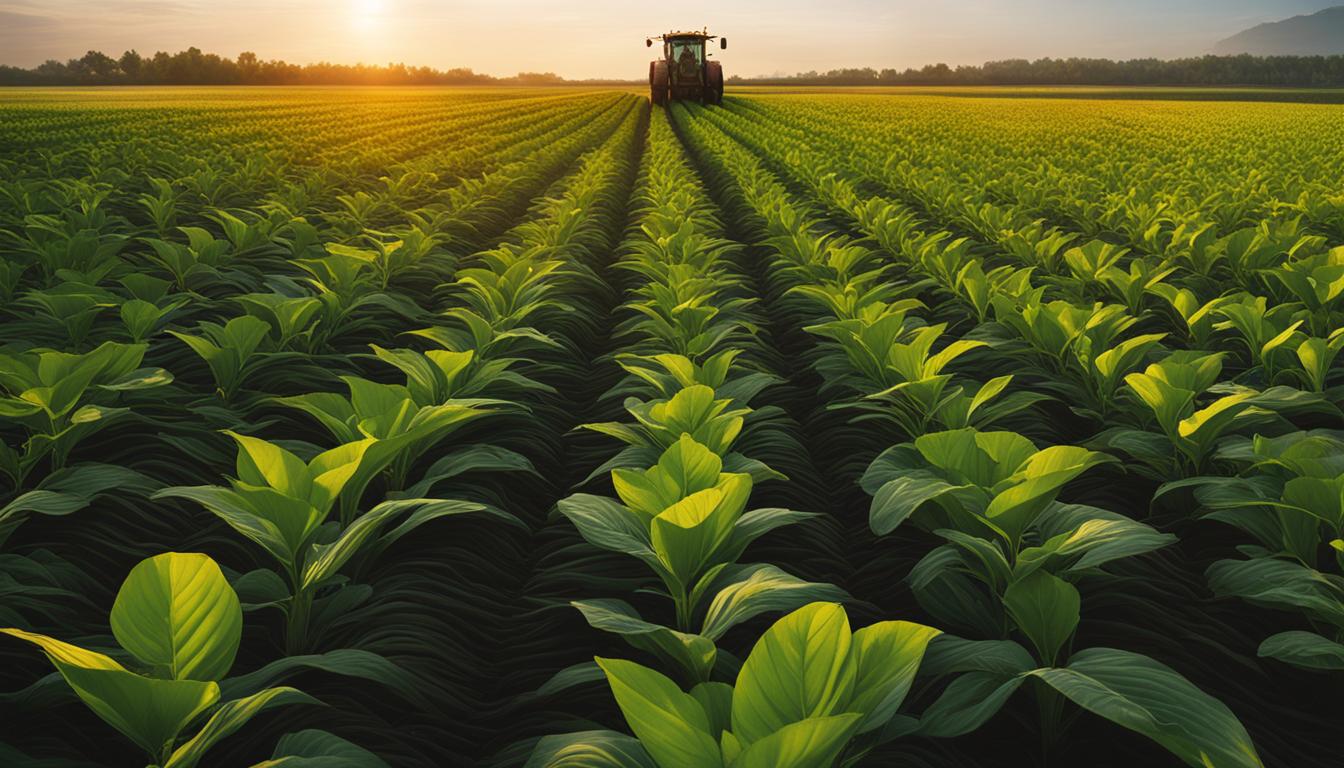Earth is experiencing a global increase in atmospheric vapor pressure deficit (VPD) due to climate change. This increase in VPD has been associated with productivity decreases in ecosystems and yield penalties in crops. The primary cause of these losses is decreased stomatal conductance, which limits photosynthesis. However, research suggests that stomatal acclimation to VPD plays a crucial role in determining plant productivity under high VPD. Elevated VPD can also have complex effects on plant physiology at the anatomical, biochemical, and developmental levels. These effects can vary across species and impact yield, primary productivity, leaf anatomy, nutrient and hormonal status, reproductive development, and architecture and growth rates. Understanding the relationship between VPD and plant stress is essential for mitigating the effects of climate change on ecosystems and agricultural systems.
Key Takeaways:
- VPD is increasing globally due to climate change, leading to decreased productivity in ecosystems and crops.
- Stomatal acclimation to VPD plays a crucial role in determining plant productivity under high VPD.
- Elevated VPD has complex effects on plant physiology, impacting various aspects of plant growth and development.
- The effects of VPD on plants can vary across species and can have implications for yield, primary productivity, leaf anatomy, nutrient and hormonal status, and reproductive development.
- Understanding the relationship between VPD and plant stress is important for developing strategies to mitigate the effects of climate change on ecosystems and agricultural systems.
Vapor Pressure Deficit and Climate Change
Climate change is causing a global increase in atmospheric vapor pressure deficit (VPD), leading to a phenomenon known as atmospheric drying. This rise in VPD is a result of two factors: an increase in saturated vapor pressure due to rising temperatures and a decrease in actual vapor pressure. As a consequence, water vapor becomes more scarce in the air, creating a drier environment.
The implications of this atmospheric drying are profound. Higher VPD has been linked to decreased growth and productivity of vegetation, increased forest decline, reduced crop yields, and an elevated incidence of wildfires. These effects are particularly pronounced in arid and semiarid regions, where the availability of water becomes even more limited as VPD rises.

The Effects of Rising VPD
Rising VPD negatively impacts plant physiology and productivity. One of the key mechanisms through which this occurs is a reduction in stomatal conductance, the process by which plants regulate gas exchange with the environment. As VPD increases, stomatal conductance decreases, resulting in reduced transpiration and limited carbon assimilation through photosynthesis. This decline in stomatal conductance becomes a primary cause of reduced plant productivity as the exchange of gases, including carbon dioxide, becomes inefficient.
To fully understand the effects of rising VPD on plant health, it is necessary to consider the complex interplay of other factors such as leaf anatomy, shoot architecture, root growth, and reproductive development. These aspects of plant physiology can also be influenced by elevated VPD, affecting water transpiration, nutrient uptake, and resource allocation. Therefore, it is crucial to study the comprehensive impact of VPD on different aspects of plant anatomy and development to develop effective strategies for enhancing plant resilience.
The Future of VPD and Climate Change
To mitigate the negative effects of VPD-mediated climate change, further research is needed to improve our understanding of the relationship between VPD and plant stress. This includes studying the differential impacts of VPD on different plant groups, developing accurate predictive models, and identifying effective adaptation strategies. By gaining a deeper insight into the effects of VPD and climate change on ecosystems and agricultural systems, we can ensure the long-term sustainability and resilience of our planet.
The Role of Stomatal Conductance in VPD-Induced Plant Stress
Stomatal conductance plays a vital role in plant responses to VPD-induced stress. When VPD increases, stomatal conductance decreases, resulting in reduced transpiration and limited carbon assimilation through photosynthesis. This decrease in stomatal conductance is a primary cause of reduced productivity, as plants are unable to efficiently regulate the exchange of gases with the environment. Stomatal acclimation to VPD is crucial in determining plant productivity under high VPD conditions. Acclimation involves changes in stomatal density, size, leaf venation, internal leaf anatomy, shoot architecture, root growth, and biochemical composition.
Understanding the mechanisms of stomatal conductance and its response to VPD is essential for developing strategies to improve plant resilience and productivity under changing climatic conditions. By studying the relationship between stomatal conductance and VPD-induced stress, researchers can gain insights into the physiological responses of plants and identify potential targets for enhancing their ability to withstand VPD-induced stress. This knowledge can inform the development of crops with increased tolerance to high VPD conditions, as well as the implementation of cultivation practices that minimize the negative impact of VPD on plant productivity.
In addition to stomatal conductance, other factors such as leaf anatomy, shoot architecture, root growth, and reproductive development also contribute to the overall impact of VPD-induced stress on plants. Changes in leaf anatomy can affect water transpiration and nutrient uptake, while alterations in shoot architecture and root growth can impact resource allocation and water availability. Therefore, a comprehensive understanding of the interactions between stomatal conductance and these other factors is crucial for developing effective strategies to enhance plant resilience and productivity under VPD-induced stress.
The Relationship Between Stomatal Conductance and Photosynthetic Limitations
One of the key consequences of reduced stomatal conductance under high VPD conditions is the limitation of photosynthesis. Stomatal closure decreases the entry of carbon dioxide into the leaf, thereby reducing the rate of photosynthesis. This photosynthetic limitation has direct implications for plant productivity and growth. By studying the relationship between stomatal conductance and photosynthetic limitations, researchers can gain insights into the physiological processes that regulate carbon assimilation in plants under high VPD conditions.
VPD Effects on Different Plant Groups
As the atmospheric vapor pressure deficit (VPD) increases due to climate change, it is essential to understand its effects on different plant groups. Quantitative studies have revealed that the impacts of VPD vary across plant species, highlighting the importance of community assembly and crop functional diversity. By examining the responses of 112 plant species to VPD increase, researchers have identified trait variations that can inform predictions about the future impacts of VPD on plant productivity and ecosystem function.
A comprehensive understanding of the effects of VPD on plant groups is crucial for developing strategies to mitigate VPD-induced stress. Whether it is a natural ecosystem or an agricultural system, the composition of plant communities and crop species plays a vital role in determining the overall impact of VPD increases. By characterizing the responses of different plant groups to rising VPD and exploring strategies to improve community assembly and crop functional diversity, it becomes possible to reduce the negative consequences of VPD-induced stress on plant productivity.
Table: VPD effects on different plant groups
| Plant Group | VPD Effects |
|---|---|
| Grasses | Reduced leaf area, decreased biomass production |
| Trees | Increased susceptibility to drought stress, reduced growth rates |
| Herbs | Decreased reproductive success, altered flowering patterns |
| Crops | Reduced yield, decreased nutrient uptake |
By considering the specific effects of VPD on different plant groups, it becomes possible to develop targeted strategies for managing VPD-induced stress. For example, for grasses, such as wheat or barley, measures to enhance root growth and improve water use efficiency could help mitigate the negative impacts of VPD on biomass production. For trees, implementing practices that improve drought tolerance, such as mulching and efficient irrigation techniques, can aid in maintaining growth rates under increasing VPD conditions.
Overall, understanding the differential effects of VPD on different plant groups is crucial for predicting and mitigating the impacts of climate change. By improving community assembly and crop functional diversity, it becomes possible to enhance plant resilience and ensure sustainable ecosystem function and agricultural productivity in the face of rising VPD.
Linking VPD to Crop Yield
One of the significant consequences of increasing VPD is the negative impact it has on crop yield. Historical data has shown that rising VPD has been associated with yield penalties in major agricultural regions worldwide. In regions like the United States and China, significant decreases in crop yields, particularly for maize, soybean, wheat, rice, and other staple crops, have been observed. These yield penalties can have severe implications for food security and agricultural sustainability.
For example, in the United States, VPD conditions have been identified as a significant driver of maize and soybean yield reductions. Despite advancements in agricultural practices and genetics, these crops have seen decreasing yields and even negative genetic gains due to the effects of VPD. Similarly, in China, rising VPD has been linked to yield decreases in wheat, rice, maize, and soybean, posing a threat to the country’s food production. Even flooded rice yields in the Indian subcontinent have been negatively impacted by increases in VPD.
These findings underscore the importance of considering the effects of VPD on crop yield predictions and agricultural productivity. As VPD continues to increase with climate change, it becomes crucial to develop strategies and technologies that can mitigate these negative impacts and ensure sustainable food production.
| Crop | Region | Yield Impact |
|---|---|---|
| Maize | United States | Negative genetic gains |
| Soybean | United States | Decreased yields |
| Wheat | China | Yield reductions |
| Rice | China, Indian subcontinent | Decreased yields |

The table above highlights the impact of VPD on crop yield across different regions. It is essential to acknowledge these negative consequences and develop strategies that can enhance crop resilience and productivity under VPD-induced stress. By understanding the relationship between VPD and crop yield and implementing appropriate adaptation measures, we can work towards ensuring sustainable agriculture and food security in the face of climate change.
VPD Effects on Plant Anatomy and Development
Long-term exposure to vapor pressure deficit (VPD) can have significant effects on plant anatomy and development. When plants are subjected to high VPD conditions, they undergo various physiological changes that impact their overall resilience and productivity. These changes include alterations in leaf anatomy, shoot architecture, root growth, and reproductive development.
One of the key effects of VPD on plant anatomy is the alteration of stomatal density, size, and leaf venation. Stomata, the tiny pores on the surface of leaves, play a crucial role in gas exchange and water regulation. In high VPD conditions, plants tend to decrease stomatal density and size, which can reduce water transpiration but also limit nutrient uptake. These changes can have a profound impact on the plant’s ability to regulate its internal environment and maintain optimal physiological processes.
Furthermore, VPD-induced stress can also affect shoot architecture and root growth. Plants exposed to high VPD often exhibit changes in the overall shape and structure of their shoots, such as shorter internode lengths and altered branching patterns. These adaptations are believed to help plants optimize resource allocation and enhance their water-use efficiency. Additionally, VPD can influence root growth, leading to changes in root system architecture and distribution. These alterations in root growth can impact the plant’s ability to access water and nutrients, further influencing its overall health and productivity.
The Impact of VPD on Reproductive Development
In addition to the effects on leaf anatomy and shoot architecture, VPD can also impact reproductive development in plants. High VPD conditions have been shown to affect the growth rate and development of reproductive organs, such as flowers and fruits. These changes can lead to reduced seed and fruit production, ultimately impacting crop yields and overall plant reproductive success.
Empirical evidence suggests that understanding and mitigating the effects of VPD on plant anatomy and development is crucial for enhancing plant resilience under changing climatic conditions. By comprehending how VPD affects these vital aspects of plant physiology, researchers and agricultural practitioners can develop strategies to improve crop productivity and mitigate the negative consequences of VPD-induced stress.

Monitoring VPD Effects on Plant Health
Monitoring the effects of Vapor Pressure Deficit (VPD) on plant health is crucial for understanding and managing plant stress responses. By continuously assessing VPD, we can identify early signs of stress and implement timely interventions to mitigate the negative effects. Various methods can be used to monitor VPD, including measuring stomatal conductance, gas exchange rates, infrared gas analyzers, infrared thermometry, and remote sensing. These monitoring techniques allow us to quantify the impact of VPD on plant physiological processes and assess overall plant health.

Stomatal conductance, which regulates the exchange of gases between plants and the environment, is a key parameter for evaluating VPD effects. By measuring stomatal conductance, we can determine the extent to which VPD is affecting plant water status and gas exchange. Gas exchange rates provide further insights into plant respiration and photosynthesis, helping us understand any limitations imposed by VPD-induced stress. Additionally, infrared gas analyzers and infrared thermometry allow for non-invasive monitoring of VPD effects, providing valuable data for assessing plant responses in different environmental conditions.
Remote sensing techniques, such as satellite imagery, can also be used to monitor VPD effects on a larger scale. By analyzing remote sensing data, we can assess vegetation indices, such as leaf area index and normalized difference vegetation index, which provide information about plant health and photosynthetic activity. These indices can help identify areas experiencing VPD-induced stress and guide targeted management strategies. Furthermore, advancements in remote sensing technology, such as thermal infrared cameras, offer the potential for high-resolution monitoring of VPD effects at the individual plant level.
In summary, monitoring VPD effects on plant health is essential for detecting stress and implementing appropriate management strategies. By utilizing various monitoring techniques, such as measuring stomatal conductance, gas exchange rates, and remote sensing, we can assess the impact of VPD on plant physiological processes and identify early signs of stress. Continuous monitoring of VPD allows for proactive interventions to mitigate the negative effects of VPD-induced stress and ensure the overall health and productivity of plant populations.
Implications for Climate Change Adaptation
The complex effects of vapor pressure deficit (VPD) on plant physiology, productivity, and resilience have significant implications for climate change adaptation. Understanding these effects is crucial for developing effective strategies to mitigate the negative consequences of VPD-mediated climate change. By considering the following implications, we can enhance plant resilience and ensure the long-term sustainability of ecosystems and agricultural systems.
Enhancing Plant Resilience
- Selection of stress-tolerant crop varieties: Developing and utilizing crop varieties that are more resilient to VPD-induced stress can help maintain productivity and minimize yield losses.
- Optimizing irrigation practices: Implementing efficient irrigation techniques that minimize water losses and optimize water use efficiency can help alleviate the effects of VPD on plant health and productivity.
- Improving soil water management: Enhancing soil water retention capacity through practices such as organic matter additions, conservation tillage, and cover cropping can improve plant water availability and reduce the impact of VPD.
Modeling and Predicting VPD Impacts
Comprehensive modeling frameworks that consider multiple physiological factors are essential for predicting the impacts of VPD on ecosystems and agricultural systems. These models can incorporate data on stomatal conductance, leaf anatomy, shoot architecture, root growth, and reproductive development to provide more accurate predictions of plant responses to VPD-induced stress. By simulating different scenarios, these models can help guide the development of targeted mitigation and adaptation measures.
Improving Adaptation Strategies
- Investing in research and development: Continued research is necessary to better understand the effects of VPD and develop innovative strategies for adapting to changing climatic conditions. This includes studying the differential impacts of VPD on different plant groups, improving modeling techniques, and identifying novel adaptation approaches.
- Promoting collaboration and knowledge-sharing: Collaborative efforts between researchers, policymakers, and practitioners can foster the exchange of knowledge and best practices for adapting to VPD-mediated climate change effects. This can help accelerate the implementation of effective adaptation strategies at various scales.
By addressing these implications, we can improve our understanding of VPD-mediated climate change effects and develop strategies to enhance plant resilience and ecosystem sustainability. Taking proactive measures now can help mitigate the negative consequences of VPD on plant health, productivity, and agricultural systems in the face of ongoing climate change challenges.

Future Research Directions
As the understanding of vapor pressure deficit (VPD) and its impacts on ecosystem function and agro-systems continues to evolve, future research should focus on addressing several key knowledge gaps. By addressing these gaps, researchers can provide valuable insights that will inform effective strategies for managing VPD-mediated climate change effects.
Impacts of VPD on Ecosystem Function
One important area for future research is the quantification of the impacts of VPD on ecosystem function. Studying the effects of VPD on ecosystem processes such as carbon and nutrient cycling, water use efficiency, and species interactions will help assess the overall resilience and functionality of ecosystems under changing VPD conditions. By understanding these impacts, researchers can develop strategies to mitigate potential negative effects and enhance ecosystem resilience.
Improving Crop Resilience to VPD
Another crucial research area is the development of strategies to enhance crop resilience to VPD-induced stress. This includes identifying stress-tolerant crop varieties, optimizing irrigation practices, and improving soil water management. By developing and implementing these strategies, farmers can minimize the negative consequences of VPD on crop productivity and ensure food security in the face of climate change.
Enhancing Modeling Frameworks
Further advancements in modeling frameworks are necessary to accurately predict and understand the impacts of VPD on ecosystems and agricultural systems. These frameworks should consider multiple physiological factors, such as stomatal conductance, leaf anatomy, and root growth, to provide comprehensive and reliable predictions of how VPD will affect different plant groups and crop yields. Improving modeling frameworks will enable researchers and policymakers to make informed decisions and develop targeted mitigation and adaptation measures.
| Research Areas | Description |
|---|---|
| Impacts of VPD on Ecosystem Function | Quantifying the effects of VPD on ecosystem processes and resilience. |
| Improving Crop Resilience to VPD | Developing strategies to enhance crop resilience to VPD-induced stress. |
| Enhancing Modeling Frameworks | Advancing modeling frameworks to accurately predict the impacts of VPD on ecosystems and agricultural systems. |
Conclusion
The relationship between VPD and plant stress is a complex and pressing issue. As global atmospheric vapor pressure deficit continues to rise due to climate change, it poses significant challenges to ecosystems and agricultural systems. The primary cause of productivity decreases and yield penalties is the decrease in stomatal conductance, which limits photosynthesis. However, it is essential to recognize that stomatal acclimation to VPD and other factors such as changes in leaf anatomy, shoot architecture, root growth, and reproductive development also play crucial roles in determining plant resilience and productivity under high VPD conditions.
Monitoring the effects of VPD on plant health is vital for early detection of stress and implementing appropriate management strategies. Different monitoring techniques, including measuring stomatal conductance and gas exchange rates, can provide valuable insights into VPD-mediated plant physiological processes. Furthermore, continuous research efforts are needed to better understand the effects of VPD on different plant groups and develop effective modeling frameworks that consider multiple physiological factors.
With a comprehensive understanding of the relationship between VPD and plant stress, we can develop targeted strategies for climate change adaptation. Enhancing plant resilience through the selection of stress-tolerant crop varieties, optimizing irrigation practices, and improving soil water management are critical steps in mitigating the negative consequences of VPD-induced climate change effects. By addressing the challenges posed by VPD, we can ensure the long-term sustainability of ecosystems and agricultural systems in the face of climate change.
Sources:

